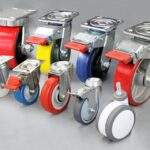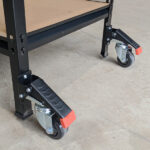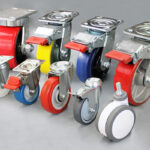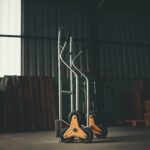Castors are essential parts of material handling equipment. They’re assemblies of wheels and mounting hardware that attach to the bottom of trolleys, carts, dollies, hand trucks, scissor lifts and more. Their basic role is to support the weight of loads and make transport and maneuvering as simple as possible. The dozens of variants mean you’ll need to carefully select the right castor for the application – whether this is castors for lighter loads and smooth surfaces, or heavy-duty variants seen in industrial uses.
Castor Basics
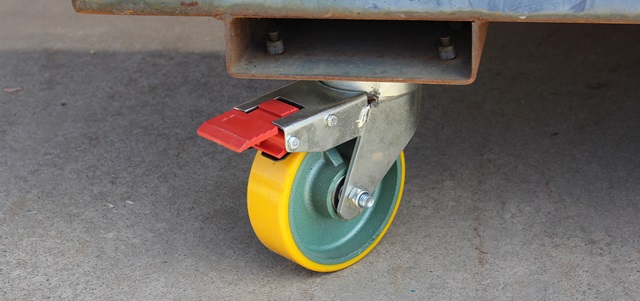
Variety is good but can be overwhelming. Castors come in two basic designs regarding how they fit the material handling equipment they’re attached to. This distinction also means different uses. For lighter loads and across smoother surfaces, for instance, office carts or hospitality trolleys, bolt-hole castors can more than adequately handle the weight while offering superior maneuverability and easy maintenance. This is compared to castors used to stabilise heavier loads in harsher settings. These attach to larger pieces of material handling equipment with plates.
Bolt-hole Castors
Bolt-hole castors are fixed to the item’s base using a single fastener. This threads into the centre of a swivel head. Here too there are several varieties, either a single bolt, a threaded stem or an expanding insert. The differences are subtle but work in slightly different ways.
Single Bolt-hole Types
As the name implies, this type of bolt hole caster uses one bolt or stud protruding from the bracket attached directly to the equipment. The benefits are a smaller footprint, simple design and lower costs while covering basic needs, such as decent loading capacity, easy maneuvering in tighter spaces, and simple replacement or maintenance if something goes wrong. All bolt casters are of the swivelling type, meaning they can negotiate tight spots such as offices, restaurants and schools without too much hassle. The assemblies are commonly found on smaller trolleys, carts, dollies and furniture (office chairs, desks, filing cabinets etc).
Threaded Stem Casters
Here threaded pins do the double duty of affixing to various items while allowing easy movement. The pins have a female thread or cylindrical hole and nut assembly. Stems are offered in different sizes (for instance to allow easier transport over rougher surfaces) and varied materials, including metal or plastics. You’ll find steel-threaded stems capable of carrying heavier loads across more demanding industrial settings, while plastic stems are reserved for lighter loads and everyday usage.
Castors with Expanding Inserts
Similar to threaded types are expanding inserts. These are also made of plastic or metal and locked into a hole or rounded tube at the base of the item. On installation, the fasteners simply snap into place by expanding a clamping wedge against the tube walls. The same material distinction in single-bolt and threaded stem types is also present here. Use metal inserts for heavier loads on similarly-built rigid metal material handling gear, or plastics for lighter loads, or wet and corrosive environments where steel may not be the optimal choice due to rusting.
Buying Considerations and Uses
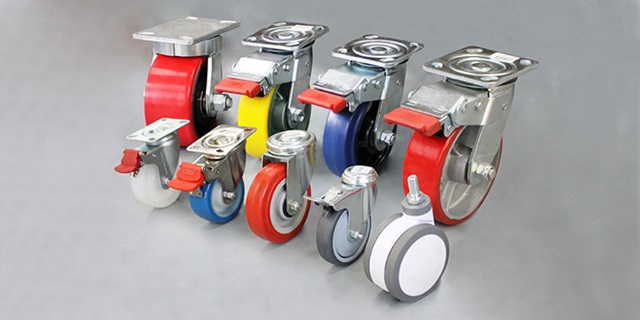
Bolt hole castors can be optioned in varied diameters and heights, a range of materials, and varying loading capacities. These are the main factors to look for when pairing the right bolt caster to the application. Diameters range from 100 to 150mm for each wheel, with thinner types better suited to tighter areas. while beefier wheels handle larger and bulkier loads where stability can be an issue. Bolt holes and threads are usually in a standard 12 mm diameter.
There’s more variation with materials. Nylon wheels are good for industrial and trolley applications, rebound rubber over rougher surfaces and road cases or transportable crates, and polyurethane wheels for light indoor usage. For heavier loads and settings with temperature extremes, also consider aluminium or cast-iron castors. For superior chemical resistance, choose glass-filled nylon or polycast iron type to handle grease, oil and other contaminants in workshops, garages and warehouses.
Lastly, consider weight loading. These castors can carry anywhere between 150 to 300 kilos, depending on configurations, materials and whether you need braked types.
Compared to Plate Types
These have integrated top metal plates with four or more holes threaded with bolts to the transport item. The design evenly spreads larger loads over a defined area, meaning more stability. Plate castors are common in bigger material handling equipment, such as pallet jacks, heavy-duty trolleys, or scissor lifts that commonly deal with loads weighing 500+ kilos.
Load capacities can also be extended with design variations, such as welded plates removing play on uneven surfaces, or heavy-duty bearings reducing roll-resistance over larger distances. Each plate castor can comfortably handle huge loads, with some rated for 1000 kilos or more. They come almost exclusively with bigger metal or composite plastic wheels, offered in rigid or swivelling types, and rear variants are usually of the braked type for increased safety. The better build, bigger sizes, and higher durability and loading capacities generally lead to higher prices.

